 By Ray Rivers By Ray Rivers
October 2, 2014
BURLINGTON, ON
It seems everybody wants to have a referendum these days. I’m in Italy visiting Venice this week and it turns out the folks out here are planning a ‘Scotland-style’ plebiscite for independence from Italy.
Some separation enthusiasts ran an on-line poll last March and claimed that an overwhelming number of respondents wanted to separate from Italy. Interestingly, like the Scots, they still wanted to stay in the EU and be a part of NATO.
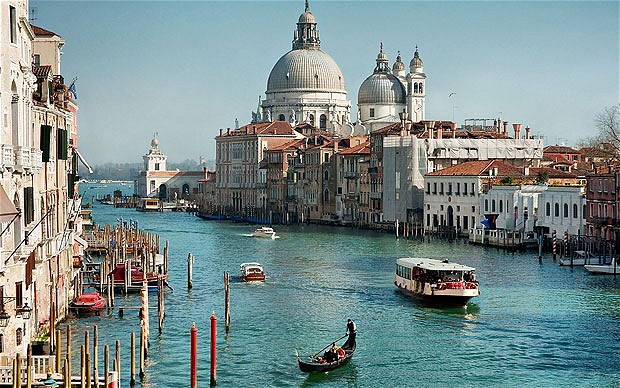 Gazette columnist cover Venetian plans to secede from Italy. That survey has encouraged Veneto, the regional entity of five million people, which includes the cities of Venice and Verona, to hold a more formal referendum. In fact a referendum was the basis for this north-eastern region to join Italy in the first place. Veneto has a colourful history. It was occupied by, among others, Attila the Hun, the Romans, the French and the Austrians. And as we know from reading Shakespeare, there was also a long period of self-government as well.
I wasn’t the only one visiting Venice. Besides the usual early autumn tourist hordes, it turns out that George Clooney, the actor, chose Venice for his wedding with British human-rights lawyer Amal Alamuddin last weekend. No, I wasn’t invited to the wedding, but I still admire Clooney as an actor, and I like the way he speaks out on the things he stands for, especially global climate change.
The city of Venice had been sinking for ages, partly from all the building on the islands and partly from the depression caused by pumping out too much ground water. Government has taken measures to eliminate that sinking feeling, but its still going to be a wet future for this ‘city of bridges’. Global climate change has already raised water levels and the future will see the Adriatic blanketing a wide swath of coastal north-eastern Italy. Fish will swim where mankind used to walk.
 New Yorkers march in the streets to save the planet. Burlington had a smaller crowd. A huge crowd demonstrated in New York last week, as world leaders met to decide what to do about climate change. Over three hundred thousand people came out to demand action, but all they got from the government leaders present, were the usual well-intentioned but meaningless speeches. President Obama got up to the podium to tell the rest of the world that it should do as he says – not as he does (or doesn’t). But at least his sentiments sounded sincere.
Canada, on the other hand, ganged up with Australia and Japan to make sure that the Kyoto Treaty was dead and could never be used to reduce global greenhouse gas emissions. In fact, our Harper, who was in New York at the time of the climate change meeting, didn’t even show his face. And that was probably just as well, since the last thing anybody needs to hear is another speech with more promises that his government has no intention of keeping.
China, now the world’s largest polluter did promise to reduce its greenhouse gas emissions a tad – but not nearly enough. And Russia is too busy selling its vast fossil fuel reserves, or threatening its neighbours, to even think about reducing its carbon footprint. Europe is still optimistic that it can make progress. Munich, for example, is promising to eventually become carbon-free, but their biggest worry today is ensuring a good supply of Russian natural gas.
It was Peter Drucker who characterized management as the science of doing things right – and leadership, the art of doing the right thing. Many world leaders came to New York last week to talk about mitigating an ever-worsening global climate change. Sadly, there was little evidence of good management and no sign of leadership whatsoever.
The locals in Venice told me that the worst floods come in November and December. I was in Venice at the end of November a few years back, while attending one of those climate change conference. Water, water everywhere, and raised wooden platforms set on top of the sidewalks to avoid getting one’s feet too wet. It does really kind of takes away from the romance of it all.
 George Clooney marries in Venice. Gazette columnist wasn’t invited. But there was a lot of romance at the Clooney wedding party, I heard. A hundred people, movie stars and other friends, added their weight onto the sunken ground of Venice. George Clooney, Willie Nelson, Neil Young have been outspoken on climate change and they have been attacked in return. But the way I look at it – if not them, then who will take the moral high ground – certainly not Canada’s PM.
Heading back to the train to take me from Venice to Florence, I took the Vaporetto (ferry service) and couldn’t help wondering about the amount of carbon emissions pouring out of the stacks of these boats as thy feverishly criss-crossed the canals. And I couldn’t help feeling guilty at having come here and adding to the carbon footprint of Venice and Italy. But then it is good that I am aware, at least, and I suppose I’m going to have to get used to that feeling or do something about it.
 Ray Rivers writes weekly on both federal and provincial politics, applying his more than 25 years as a federal bureaucrat to his thinking. Rivers was a candidate for provincial office in Burlington where he ran against Cam Jackson in 1995, the year Mike Harris and the Common Sense Revolution swept the province. Ray Rivers writes weekly on both federal and provincial politics, applying his more than 25 years as a federal bureaucrat to his thinking. Rivers was a candidate for provincial office in Burlington where he ran against Cam Jackson in 1995, the year Mike Harris and the Common Sense Revolution swept the province.
Links
Venice Referendum Veneto Issues Venice
Clooney Wedding Clooney
Obama climate Change Harper and the Climate Conference Climate Change Demonstration
Canada and Climate Change Renewable Energy Optimistic Energy
Peter Drucker

 By Pepper Parr By Pepper Parr
September 30, 2014
BURLINGTON, ON.
Here’s a rich one for you.
Three candidates for the public school board have signed a “pledge: to: “act with the highest level of integrity”.
Doesn’t one just do that when they run for public office?
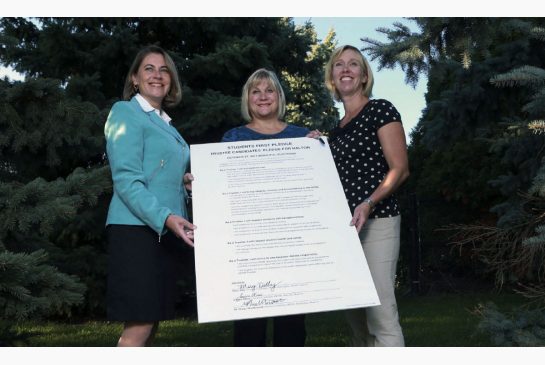 School board trustee candidates Joanne Oliver, Mary Dilly and Margo Shuttleworth hold a copy of the pledge they signed. It sounds like a groom saying to his bride at the altar that he won’t cheat on her.
Joanna Oliver, Mary Dilly and Margo Shuttleworth are all running for seats on the school board where the honorarium is at the $15,000 range. Dilly who has been a school board trustee in the past is using election signs asking people to “re-elect” her – a tactic which some see as mi sleading. sleading.
To sign a pledge to be transparent and act with integrity while demonstrating the opposite in their campaign does not set a good example to the students they are vying to represent.
“We’re hoping everyone keeps the best interests of kids in mind, and not their own agendas,” said Mary Dilly, a former trustee who is running again in Burlington. She created the Halton version of the pledge with Joanna Oliver, running in Oakville, and Margo Shuttleworth, vying for a seat to represent a different Burlington ward.
“We wanted to make the type of pledge that anyone who is running to be a trustee would want to sign, something open and transparent,” added Shuttleworth.
Looks like an advertising gimmick. Why not talk about the way you will represent the students and their parents should you get elected as a trustee.
There is a reason for calling these people trustees – you are supposed to be able to trust them.

 By Pepper Parr By Pepper Parr
September 25, 2014
BURLINGTON, ON
The cheque books came out and in less than half an hour the 100 Women Who Care Burlington voted to support Food 4 Kids, an organization that works with our schools who have identified children/families living in poverty situations and discreetly provide the child (it goes in their backpacks) with food on weekends.
 The Gazette wrote about this group a few months ago. We told of those 100 Women as well. If it’s something you might be interested in – touch base with them. It’s amazing what women with a cheque book can do – some might put the word “amazing” in big bold black letters. The Gazette wrote about this group a few months ago. We told of those 100 Women as well. If it’s something you might be interested in – touch base with them. It’s amazing what women with a cheque book can do – some might put the word “amazing” in big bold black letters.
There are currently 76 members of the Burlington Chapter of 100 Women – room for more of you. At $100 each Food4kids could be looking at $7,600 which is a lot of lunches.
You can reach then at www.food4kids.ca.
The other organizations nominated were Burlington Breast Cancer Support Services and the Seat Yourself Campaign @ Aldershot School.
Links:
In and out in less than an hour – Humane Society benefits.
The teachers knew who they were – Food4Kids fed them

 By Staff By Staff
September 26, 2014
BURLINGTON, ON.
The city is calling the weekend Cultural Days and has a long list of events planned for the public. The Rocca Sisters, no slouches when it comes to promotion, decided to do their own cultural thing and are sponsoring Applefest at Ireland House at Oakridge Farm, 2168 Guelph Line in Burlington to celebrate the best the fall season has to offer.
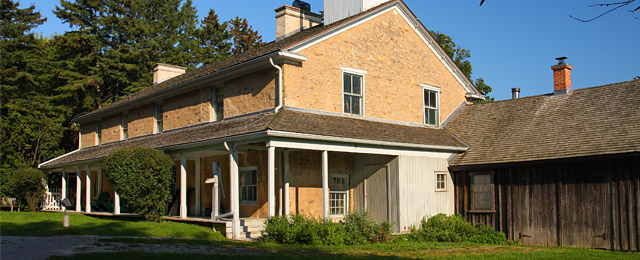 Ireland House – an original Burlington farm house that once stretched for acres on the northern edge of the city will be the location for Applefest – an occasion when the city remembers when it was the food garden for a large part of the world. This Sunday, September 28 from 11 a.m. to 4 p.m., the “sisters” invite you to join them to celebrate the best the fall season has to offer.
Admission to the event is free compliments of the Rocca Sisters as a way to say thank you to the community for all the support it has shown.
 All children will receive a free goodie bag and a special surprise from the Rocca Sisters. Stop by their tent and table to say “Hi!” and help celebrate Applefest. All children will receive a free goodie bag and a special surprise from the Rocca Sisters. Stop by their tent and table to say “Hi!” and help celebrate Applefest.
Funds raised at Applefest go towards Museums of Burlington’s educational programs and preservation of the historic collection.

 By Pepper Parr By Pepper Parr
September 25,2014
BURLINGTON, ON.
There aren’t many opportunities to say that you don’t like something without going to a lot of effort or offending someone.
There is a word out there that is offensive but it is still in use. The moment I write the word I give it currency and I’m reluctant to do that – so let me say it begins with R end in D and has four letters in between.
 In the soccer world the yellow card is a caution – it is being used to caution people who choose to use a really repugnant word. It’s a repugnant word, filled with hurt and harm and not in the least bit funny.
There is a group that wants to extinguish the word and they’ve come up with a program to get us to the point where the word isn’t used.
They call it they yellow card program and it is tied into the Special Olympics Canada and Canadians living with intellectual disabilities.
Motionball is a national charity that raises funds and awareness for Special Olympics Canada year-round. There is #nogoodway to use the “R-word,” and Canadians are asked to take the pledge to stop using the “R-word” and raise a proverbial yellow card when others use it socially.
In soccer, a yellow card is shown to offending players as a warning that they have crossed a line; in the same way, the Yellow Card Campaign aims to inform Canadians that using the “R-word” is offensive to those living with intellectual disabilities even if used in a way that seems harmless.
By informing and engaging without being punitive or threatening, the Yellow Card Campaign hopes to invite and inspire change, not force it.
The campaign hopes to see 36,000 Canadians take the pledge online to stop using the “R-word” – a figure that reflects the number of registered Special Olympics athletes across Canada.
In addition to the social change the campaign hopes to inspire, the Yellow Card Campaign’s corporate sponsors and private donors have come together to donate $1 to motionball for each supporter who takes the pledge online at www.motionball.com/yellowcard on Yellow CardDay which will be recognized in Halton when Regional Police Chief Stephen Tanner and Oakville Mayor Rob Burton will be taking the pledge and helping to kick off the event in the Rotunda at the Halton Regional offices on Wednesday, October 1, 2014 at 10:00am
By taking the pledge on behalf of the almost one million Canadians living with an intellectual disability, supporters not only promise to stop using the “R-word”, but also to raise a proverbial yellow card when others use it casually.

 By Pepper Parr By Pepper Parr
September 24, 2014
BURLINGTON, ON
The spin at the Art Gallery of Burlington has begun.
The announcement that he had left the Art Gallery was made by Ian Ross on his Facebook page.
Sandra Edrup, Chair of the AGB said this morning that Ian Ross and the board met last week and mutually agreed that Ian Ross’s 20 years at the gallery would come to an end.
That was last week – but there was no announcement until the Gazette broke the story earlier this morning.
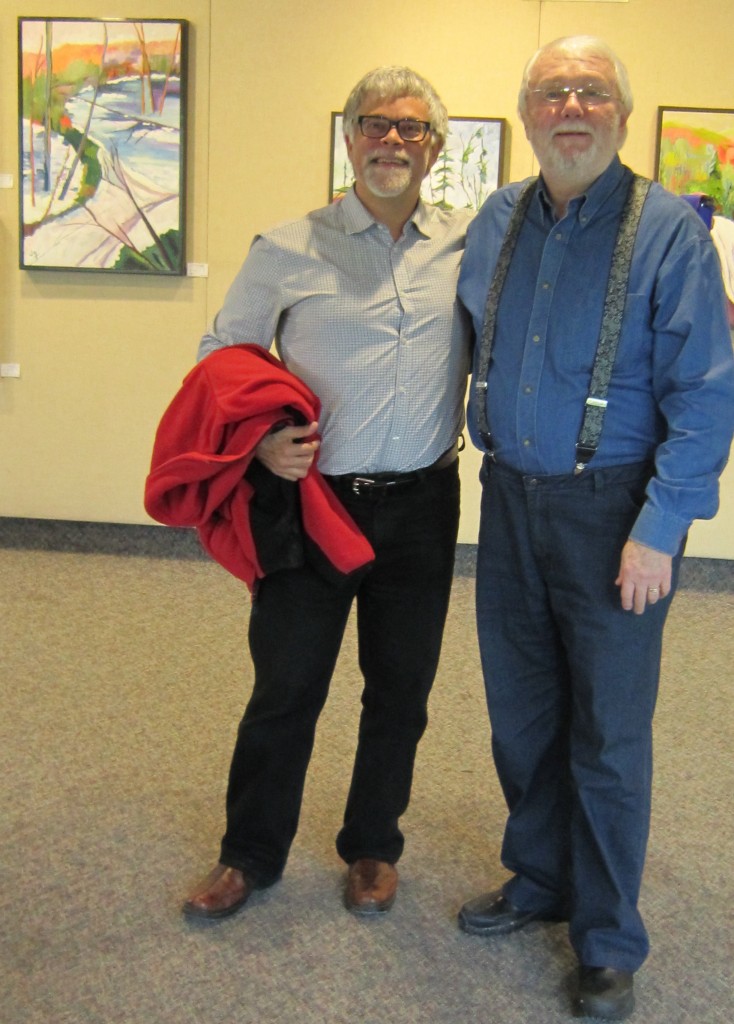 Ian Ross in better days at the Art Gallery of Burlington Kim Varian, Doug Niven and Denis Longchamps are serving as a sort of triumvirate to run the gallery on a day to day basis while Anne Swarbrick serves as a volunteer temporary Executive Director.
A search team will be put together said Ms. Edrup that will be inclusive and include all the stake holders and the wider community to find a new President and CEO
The phrase “support for success” has entered the language the senior AGB people are using and there was mention of confidentiality and Ian’s career future.
Was the parting of ways the result of philosophical differences over how the new branding was to be put into play? Or was there a clash of wills between some of the newly appointed senior staff?
Ross has not been available for comment.
The AGB is an important part of the cultural tapestry of Burlington – it matters and the public that pays a large part of the tab deserves as much transparency as possible. They didn’t get it today.

 By Pepper Parr By Pepper Parr
September 24, 2014
BURLINGTON, ON.
Burlington is going to elect four school board trustees to the 11 member Halton District School Board. Of the four, incumbent Jennifer Hlusko has decided to run as a city Councillor and Diane Bower has retired.
Amy Collard was acclaimed and Kristen Lockhead is running for re-election.
There will be a trustee that will represent wards 1 and 2
Mary Dilly, Leah Reynolds and Judy Worsley are going after that seat. Dilly has been a candidate for public office in the past; Leah Reynolds got a very strong endorsement from Ward two Councillor Marianne Meed Ward.
There will be a trustee that will represent wards 3 and 6
Andrea Grebenc, Michael Kukhta, Denise Nacev and Timothy Timar are in the race for the trustee seat for wards three and six.
There will be a trustee that will represent ward 4, Kristen Lockhead is seeking re-election, Richelle Papin and Margo Shuttleworth are challenging the incumbent.
The trustee that will represent ward 5 was acclaimed. Amy Collard was also acclaimed in 2010. She has served as Chair of the Board in the past
 Getting students to school safely is a major task; the Burlington schools still need crossing guards. Current chair Kelly Amos informs us that the Trustees of the HDSB are responsible for the public school system covering all of Halton (Burlington, Oakville, Milton and Halton Hills), which is made up of 103 schools, over 60,000 students and approximately 5,500 employees. Those numbers increase every year. One of the responsibilities of Trustees is the approval and making sure of the compliance of the operating and capital budgets. The 2014 -15 operating budget for the HDSB totals $664.3 million and the capital budget totals just over $50 million.
She adds: As a basis of comparison, from their respective websites, the City of Burlington whose capital and operating budgets combined are $204.8 Million. The Councillors’ salaries are $51,000 for local and $48,700 for regional, for a combined salary of $99,700 and the mayor’s is a combined salary of $122,594. The Town of Oakville’s combined capital and operating budget is $264.1 million and for salary the local councillor’s is $45,737, the local regional Councillors is $88,514 and the Mayor’s is $116,693. Milton’s combined budgets are $162.2 million and the salaries for the members of council are $28,966 each and for the mayor is $69,954. The Town of Halton Hills combined budgets are $112.4 million and the councillors’ salaries for the next term will be $29,995 each and the mayor’s will be $73,008.
As a bit of history, courtesy of Ms Amos; in March 2006 the Liberal Government issued a paper Ontario Excellence for All – Respect for Ontario School Trustees and in it states;
 The Alton Village public school is a recent addition to the more than 100 schools in the public system. “School board trustees are the oldest forms of elected representation in Ontario. Since 1807, generations of community-minded citizens have made decisions on behalf of local publicly funded schools, building the foundation of the system we have today. Despite this longevity and contribution, the trustee role is widely under-appreciated and misunderstood.” As well it said “While many trustees volunteer considerable amounts of their time, the importance of informed participation requires a more realistic honorarium to ensure sufficient time is available. Since 1997, the honorarium has been limited to $5000 per year, with chairs and vice-chairs eligible to receive up to $5000 more per year.”
An Ontario Regulation required the formation of a Citizens’ Advisory Committee, which was to recommend to the Board a base amount as well as an attendance amount and distance amount for each member of the Board of Trustees for each year of their term of office. This committee was comprised of parents from all across Halton and decided;
For the period starting December 1, 2006 and ending November 2010, trustee honoraria would be:
Base Amount, Enrolment Amount, Total Amount
Member $ 5,900.00 $ 7,285,59 $ 13,158.59
Chair 10,900.00 9,575.35 20,475.35
Vice-Chair 8,400.00 8,430.27 16,830.47
The current motion that is before the Board to be voted on in September WAS THIS PASSED? is dealing with an amount that was set in 2006 and there has been no increase since then. This motion if approved by the Board will come into effect at the beginning of the next elected Board of Trustees effective December 1, 2014.
Base Amount, Enrolment Amount, Attendance Total Amount
Member $ 6,324.80 $ 9,445.55 1,000.00 $ 16,770.35
Chair 11,324.80 12,414.15 1,000.00 24,738.95
Vice-Chair 8,824.80 10,929.85 1,000.00 20,754.65
At a school board meeting on September 3rd, the Trustees approved a new rate for trustee honoraria that takes effect December 1, 2014 when the 2014-2018 Board begins its term. Trustees will receive an annual honoraria of $16,770.35 while the Chair will receive a total of $24,738.95 and the Vice-chair a total of $20,754.65.
The base amounts have been increased by the percentage increase in the Consumer Price Index for the period between July 1, 2010 and April 30, 2014 and the enrollment amounts are based on the 2013/2014 ADE (Average Daily Enrolment) of the Halton District School Board.
 Amy Collard has been acclaimed for the ward five public school board seat Trustees’ salaries come from an enveloped amount of money from the Ministry which is designated for Board Administration and Governance. This means this money is only used for Board Administration and Governance and cannot be used for anything else, and does not take away from any funding for students or program use.
 Jennifer Hlusko will be giving up her public school board seat – she is running for the ward six municipal council seat – running against incumbent Blair Lancaster. Each Trustee can spend a different amount of time on being a trustee. Current Chair Kelly Amos said she typically puts in a 30 – 40 hour week depending on what is going on and what needs to be done.
In the weeks ahead the Gazette will endeavour to interview all the candidates for the public school board. Time just doesn’t permit our covering the Catholic school board.

 By Pepper Parr By Pepper Parr
September 21, 2014
BURLINGTON, ON.
She pulled it off. With the help of her husband Dean and one of the most impressive collections of volunteers we have ever seen in this city, Selina Jane Eckersall held her second No Vacancy event, this time at the Village Square.
Jack Friedman, the man who built the Village Square, must have smiled when he learned that the space he created was being used the way he wanted it to be used.
Eckersall held her first No Vacancy at the Waterfront Hotel in 2013. It was a critical success and drove her to growing the concept and worked out an arrangement with the property owners at the Village Square to use the empty space.
Eckersall estimates there were between 2,000 and 5,000 people at the event – that is too wide a spread – the real number was somewhere above 3,500 based on what we observed.
Eckersall wasn’t prepared to say which was the best of the 30 installation but she did say that Appollonia Vanova and the Grand Connection were very popular.
 Lovely colours 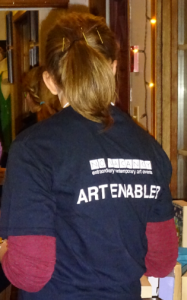 The volunteers were superb. The volunteers were exceptional. If you had a question – they had an answer or they got you an answer quite quickly.
There were times when the space around the gazebo was packed so tightly you could hardly move. It was a friendly crowd – not a hooligan in sight.
In a city the size of Burlington most people know someone and the chance to meet up was just fun. Patrick Bermingham one of the artists, decided to rent one of the empty spaces for his own purposes and held a private party. He was able to invite all his friends, offer them a drink and have people get out to see some of the installations and come back to chat about what they had seen. Expect to see more of that next year.
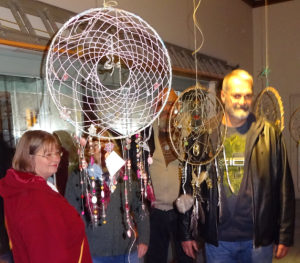 Dream catchers. And there will be a next year. Eckersall was going through what worked and what didn’t work. The installations at the Gym on Pearl didn’t get the traffic they should have gotten; the beer garden didn’t produce the revenue that was expected and Eckersall isn’t sure that she will use a portion of Pine Street next year.
Eckersall knows now that she needs to tweak the business model. The event cost about $10,000 to put on – revenue didn’t quite reach that level.
 The Juggler Sponsorship was good – but ways have to be found to increase the revenue. Selena Eckersall and her husband spent more than six months on this project and are not likely to see as much as a dime personally for their efforts. They might even have to dip into the cookie jar to make up the loss.
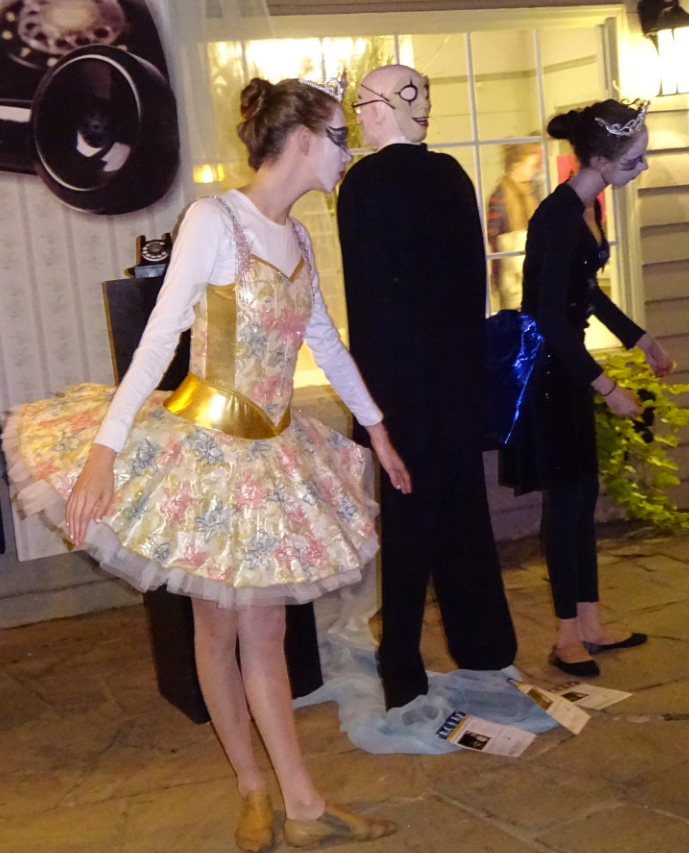 Student Theatre mannequins It was an exciting event; it left all those who attended fully appreciating their community and the sense of community that was created in the Village Square.
It was a delight to see Angelo Bentivegna working the crowd and chatting with his friends. He was in full election mode and it seemed perfectly natural.
When asked: What was the biggest thrill for you? Eckersall didn’t need a second to respond – “Seeing all those people – the excitement of the artists and how inspired they were.”
What was the biggest disappointment?
Beer sales were much lower than we expected. We need to re-think the beer garden”, said Eckersall. All the activity was inside the Village.
Despite the low beer sales “the city is hungry for this kind of stuff and that was certainly evident” Eckersall added. The challenge now is to keep the content fresh and relevant.
The Cirque was different, it wasn’t as “scrappy” as the Art Crawl in Hamilton. There was more money in the space – Burlington is a wealthier city and that was clearly evident in the traffic – no one was wearing furs but there was a sense of satisfaction in the crowds – a crowd doesn’t seem to be the right word. There were a lot of people but it was more like a community getting together.
The mannequins located throughout the Village were all courtesy of the Student Theatre. The make up on a few was close to astounding.
 This took all the seniors back to the 60’s The juggler was close to a carnival pitchman – she moved beautifully and talked about her art. The belly dancers had nice costumes.
 Suspended illusions Eckersall is now looking for operational funding and working on writing for a Trillium grant. She might want to have lunch with Kelly Arnott of the Chilly Half Marathon fame, and talk about how one finds long term sponsors.

 By Pepper Parr By Pepper Parr
September 13, 2014
BURLINGTON, ON.
So – who is it going to be? And does it matter?
Nominations closed yesterday afternoon and the city Clerk can now begin the task of preparing all the papers and getting the ballots printed. And residents of the city can begin to learn something about the people who put their $100 on the counter, signed a bunch of papers and are now going door to door to tell you who they are.
Does it matter? You bet your bippy it matters – they spend all those tax dollars you send to the city. If you live in an apartment building you might not see that tax bill but it is a large part of your rent.
Does it matter? Should you need care at the hospital – know that the city put a special tax levy in place to collect the $60 million it had to come up with to pay for the hospital. Early in the mandate of Mayor Rick Goldring he learned that – Burlington was going to have to come up with that $60 million. The city manager at the time said it was the largest financial undertaking the city had faced.
Which roads get paved – the people you elect decide that.
The PIER – yes it is built and it is nice – but was it worth twice the price it was supposed to cost? When the bill is set at more than $6 million and the final bill comes in at more than $14 million – questions need to be asked and answers need to be given. If you made a goof of that proportion in the real world you would have been fired. This is your opportunity to fire some of the people who are now on Council.
So – what are your choices:
Ward 1:
Patrick ALLEN,
Jason BOELHOUWER,
Rick CRAVEN,
Katherine HENSHELL,
Gary MILNE
Margaret Anne STEISS,
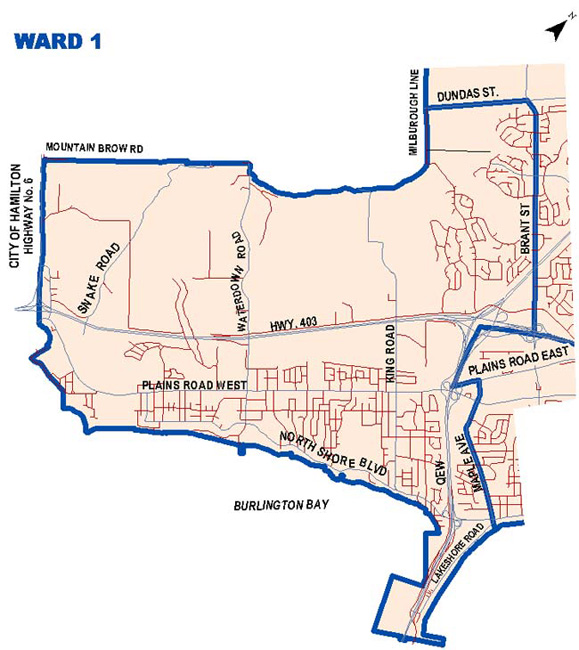 Ward 1 boundaries Rick Craven is the incumbent; he has been on Council since 2000
We have written about Henshell and Boelhouwer. A note on full disclosure, Henshell has done and is continuing to do some legal work for the Gazette. We will write about Milne, Steiss and Allan in the days ahead
Ward 2:
Kelly ARNOTT,
Marianne MEED WARD,
Philip PAPADOPOULOS,
Andy PORECKI,.
Meed Ward is the incumbent and was first elected to Council in 2010.
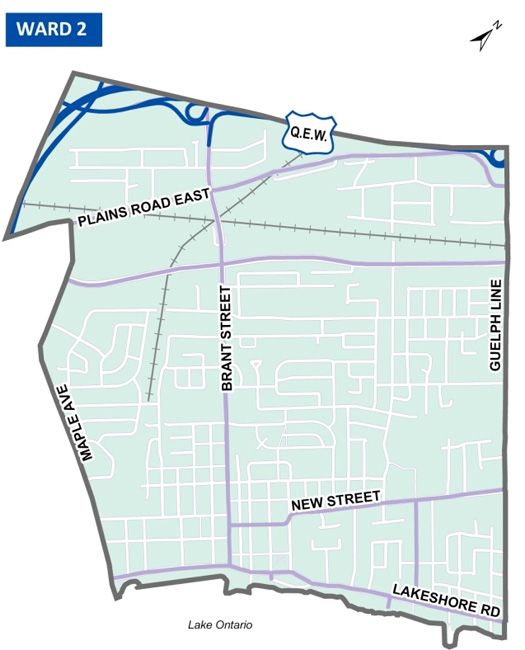 Ward 2 boundaries We have written about Arnott but not yet as a candidate. We will write about the other candidates in the weeks ahead.
Ward 3
Jeff BROOKS,
Lisa COOPER,
John TAYLOR.
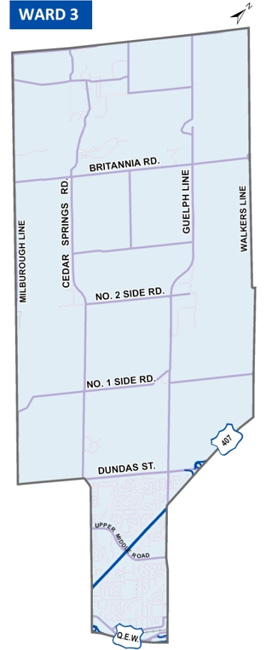 Ward 3 boundaries John Taylor is the incumbent. He is the Dean of this Council and has served for more than 20 years. Lisa Cooper has been a candidate in the past, Jeff Brooks is new to the election game. We will publish the interview we did with Lisa Cooper and will interview Jeff Brooks in the very near future.
Ward 4
Jack DENNISON,
Carol GOTTLOB,
Doug WILCOX,
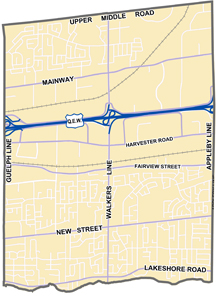 Ward 4 boundaries Jack Dennison is the incumbent and has served on Council for more than 20 years. He has been a controversial candidate and brings a distinct style to serving as a Council member.
Carol Gottlob is new to the political scene and struggles to get a campaign team together. When people meet her they appear to be impressed. we have written about Gottlob. Doug Wilcox was a last minute candidate and does not live in the ward. While that may not make much of a difference to those in the northern part of the ward – for those south of New Street it is a very big deal. The residents in that part of the city are well organized and have two community organizations.
Ward 5
Paul SHARMAN,
Ian SIMPSON,
James SMITH.
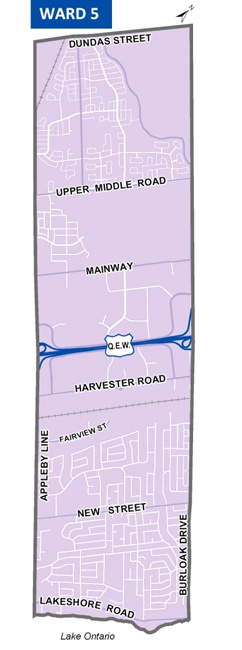 Ward 5 boundaries Paul Sharman is the incumbent and is completing his first term. He has been strong on the financial matters that come before Council and certainly changed the tone of the debate. He is adamant about data – no date he says – then no decision.
James Smith has run for public office before – ran in ward 4 and missed the brass ring by a couple of hundred votes. He has been a frequent delegator at city hall where he speaks about transit and planning.
Ian Simpson is an unknown to us. He has had his nomination in place for a number of months but we know little about him. We will interview Mr. Simpson.
Ward 6
Angelo BENTIVEGNA,
Jim CURRAN,
Pardeep Kaur DOSANJH,
Jennifer HLUSKO,
Blair LANCASTER,
Jivan SANGHERA,
Shoaib SHAMS,
Ishar THIARA,
Mina WAHIDI,
Vanessa WARREN.
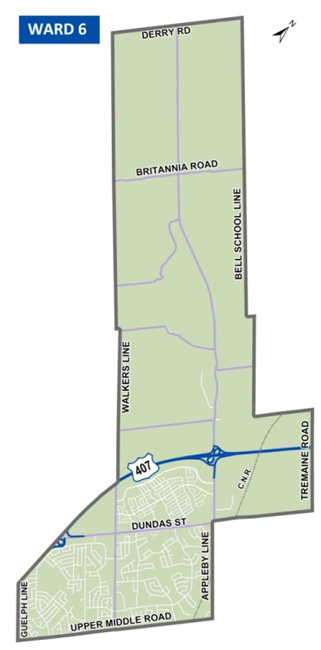 Ward 6 boundaries Blair Lancaster is the incumbent facing nine people who want that Council seat. Lancaster was first elected in 2010 in a ward that includes the Air Park and the Alton community that was not as developed as it is now in 2010.
We have written about Bentivenga, Curran, Hlusko, Sanghera and Warren. We will publish the Wahidi interview in the near future and interview the other candidates – most of whom nominated in the very recent past.
Are there any upsets possible? Lancaster is certainly at risk. Sharman could be in trouble. Dennison has name recognition that is so high he will be difficult to beat – but if his record is looked at carefully the citizens of Ward 4 might go for some fresh blood.
Should Meed Ward be defeated it will be the upset of the century for this city.
Craven can be challenged – beaten? That one is going to be an interesting race.
There is a race for the Regional chair; Mayor Goldring has been challenged by at last one creditable candidate – and there are school board trustees to be looked at.

 By Pepper Parr By Pepper Parr
September 13, 2014
Burlington, ON.
The phrase social media means different things to different people. And there are few really good examples of how social media works and the role it can play in the sharing of information.
While there are mountains of information out there – what exists may not be what you want. Perfect social media is when what you want is also what others have to share.
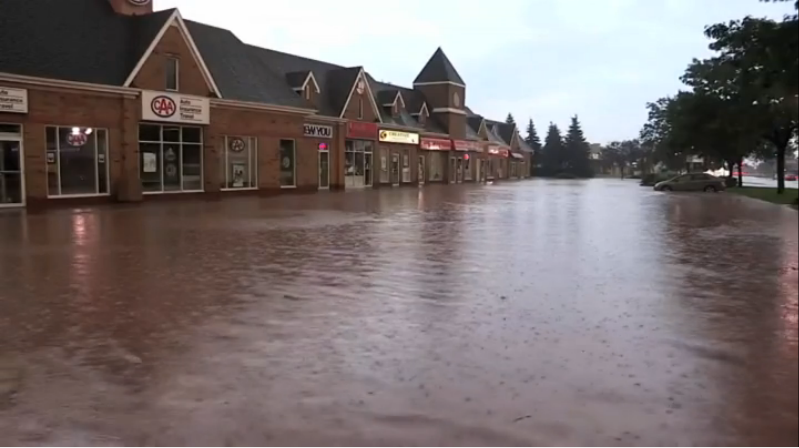 A plaza on Fairview – stores flooded. Last August 4th when rain fell on the city for close to eight hours and left 191mm of water looking for a place to go – the Weather Network was collecting data from anyone who had something to send in.
The link here is a really good example of social media doing what it is supposed to do. The piece you have looked at was obtained by the city from the Weather Network and shown at a city Development and Infrastructure committee more than a month after the rains fell.
The Weather Network took video clips sent to them and just stitched them together into a strip of film and loaded it on their web site.
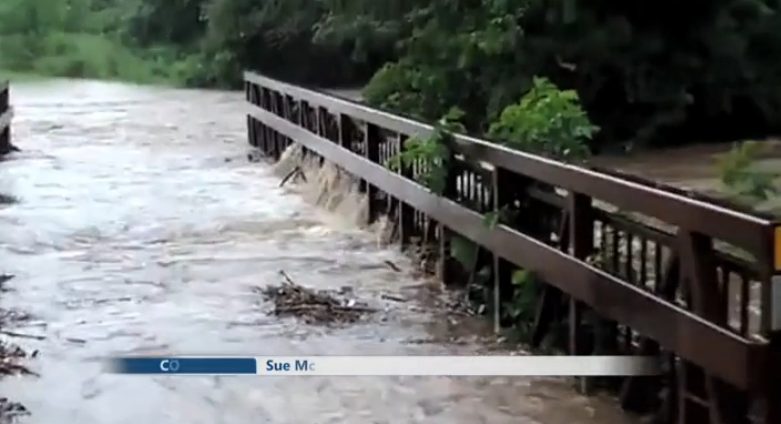 Individuals sent in clips taken from the cell cameras – which are stitched together by the Weather Network and aired. Imagine if that piece of video had been shown to the public the day after the storm – Burlington would have had a much better idea as to what had happened and the response to the flood would have been much more engaged.
Had video like this been used at the Ribfest; had the story of the flood been told to the more than 100,000 people who came from places other than Burlington – the amount raised would have been much more than the $40,000 that was raised.
That $40,000 was $40,000 more than the Community Foundation had before Ribfest and the community is grateful – but when compared to the $20,000 that one man and 35 volunteers raised in four hours on Elwood Street – questions get asked.

 By Pepper Parr By Pepper Parr
August 31, 2014
BURLINGTON, ON
A Fundraiser for the Judy LaMarsh Fund honouring the contributions of four great women in the advancement of women in Canadian politics will take place at the Holiday Inn on the South Service Road on September 6, 2014
Cost: $75 regular, $50 for Laurier/Victory Club members, and students. Tickets can be purchased on-line at www.liberal.ca/
 The Honourable Paddy Torsney, Permanent Observer to the United Nations for the Inter-Parliamentary Union. Permanent Observer to the United Nations for the Inter-Parliamentary Union.
Permanent Observer to the United Nations for the Inter-Parliamentary Union.
What is remarkable about the event is the invited guests:
The Honourable Paddy Torsney; Member of Parliament, Burlington, 1993-2006
The Honourable Bonnie Brown; Member of Parliament, Oakville, 1993-2008
The Honourable Senator Betty Kennedy; Senator, Ontario, 2000-2001
The Honourable Beth Phinney; Member of Parliament, Hamilton Mountain, 1988-2005
The Hon. Dr. Carolyn Bennett, MP for St. Paul’s Toronto will be speaking.
This event is the 20th that Paddy Torsney has sponsored in Burlington. Torsney was the woman that gave federal Liberal candidate Karina Gould the political bug.
For Torsney it was all about breaking barriers and paving the political path for women in Halton, Hamilton and across Canada. After losing the 2006 election to Mike Wallace Paddy Torsney worked as a lobbyist in Toronto and Ottawa and then accepted an appointment as the Permanent Observer to the United Nations for the Inter-Parliamentary Union.
Torsney is also a member of the Privy Council.

Everyone tells me I need to use Social Media and I guess they’re right – but I find it confusing and it takes a lot of time which is the one thing I don’t have.
James Burchill, one of the city’s most shameless self-promoters, which is what has made him the success he is explains that “one of the main reasons this important task doesn’t get done is simply because it takes time. Let’s let him tell his story.
 By James Burchill By James Burchill
August 31, 2014
BURLINGTON, ON.
Social Media is time sensitive – if you’re going to do it – you have to do it right. Social media updates, these micro messages (while short) still require time to plan, to write, to consider the overall strategy (more on that later) and time to publish.
Time management and performance studies show an interruption costs us about 15 minutes of lost time before we are able to regain our former productivity. Assuming you had to stop 3 times a day and tweet, and 2 times a day to update your Facebook page, that’s 1 ¼ hrs just there — 17% of your day.
Think about it, add a little buffer to this and you’ll easily spend 20% of your time on this task … that’s easily ONE DAY PER WEEK spent on social media!
We can all write, they teach us this basic skill from a very early age but documenting your required groceries, or penning a letter to Aunt Maggy is not the same as crafting compelling copy for business use.
And being able to perform when required and ‘get creative’ takes practice and training. You’ve heard of writer’s block, – it’s a real phenomenon and professional writers have techniques to combat this wasteful problem.
 Then there’s the issue that all professional writing is not created equal. I’ll let you in on a secret, within the hallowed halls of writers there exists a snobbery; a class system of sorts. At the risk of having ink spilled on me at the next writers ball, some writers craft content to inform, others to compel. Persuading your prospects and client to engage and interact with you is key. Then there’s the issue that all professional writing is not created equal. I’ll let you in on a secret, within the hallowed halls of writers there exists a snobbery; a class system of sorts. At the risk of having ink spilled on me at the next writers ball, some writers craft content to inform, others to compel. Persuading your prospects and client to engage and interact with you is key.
If all you needed is time and the ability to write well then you are good to go – but it isn’t that simple. In fact it is quite complex. You need to know about the technology too. You need to know how to leverage the various platforms properly and ensure you don’t goof or post to early or too late. You need skills to make these byzantine platforms turn chaos into a symphony of concordant content.
Simply put, you need to know how to use the tools. And to keep things interesting, the programmers behind these tools keep changing the game! Blink and you’ll miss an update or some other neat new function.
It requires an overall integrated marketing strategy; working in a vacuum sucks – literally.
Creating any marketing messages and syndicating them at random is a recipe for failure. And if you imagine social media is all hip, cool and “off the cuff” then you are dancing with disaster.
Better to think of your marketing messages as sled dogs, they all need to be pulling in the same direction to gain traction and make head way.
It does yields results, if you do it right. And outsourcing the task gets it done on time and as agreed. You get results – guaranteed.
And further to this, the actual efforts yield, SEO lift, increased exposure and legitimate back-links to your target URL are huge values. SEO means Search engine optimization.
 You also get additional results in the SERPS (Search Engines Results Page) listings – and any time you can secure another top 10 slot, it’s a space your competition cannot. You also get additional results in the SERPS (Search Engines Results Page) listings – and any time you can secure another top 10 slot, it’s a space your competition cannot.
Google’s mandate has always been to provide the best answer (content) to those searching. Google is always updating its algorithms to single out and better reward unique content. So if you thought re-hashed, spun, or scraped content would work … Think again.
It becomes clear that making social media work for you means getting help. OK I’m biased because this is service my team and I offer our clients, so I’m not going to get into magical numbers that “prove” how much of a good deal it is to outsource. But if you sit down and really look at all the twiddly bits & pieces that go into this task each day/week/month … it adds up quickly and outsourcing costs a fraction of the typical annual salary equivalent.
Leads generated from social media content marketing are more likely to convert into business. The science behind this is solid and speaks to millions of years of behaviour. Think crowd sourcing, social proof, ‘monkey see, monkey do’ and a myriad of other psychological precepts.
Social Marketing content gets found – the first part of a successful online marketing strategy.
Social Marketing content gets shared – necessary for your message to move through the market.
Social Marketing content works 24/7/365. You pay once for its creation and syndication and it just keeps on working. The same can be said about articles too, the Return in Investment (ROI) is amazing!
 James Burchill is the founder of the Social Fusion Network that sponsores a monthly get together where people network and do some great business. SFN is about connecting, promoting and supporting local business using social media and in-person networking events. It’s FREE to join your local SFN and membership includes all our chapters. He also sponsors the semi annual mini-trade show at the Burlington Performing Arts Centre. Learn more James Burchill is the founder of the Social Fusion Network that sponsores a monthly get together where people network and do some great business. SFN is about connecting, promoting and supporting local business using social media and in-person networking events. It’s FREE to join your local SFN and membership includes all our chapters. He also sponsors the semi annual mini-trade show at the Burlington Performing Arts Centre. Learn more

 By Pepper Parr By Pepper Parr
August 31, 2014
BURLINGTON, ON
People get the government they deserve.
If voters do their homework and read the election material they can arrive at a conclusion and decide who they want to vote for. The voters usually get it right.
However, the voters need information – and they are entitled to quite a bit more than what appears on the handouts candidates give people at the door.
Burlington doesn’t have much in the way of a tradition of pulling candidates together and letting them debate each other.
Given that it looks as if the Mayor is going to be acclaimed – because he has done such a great job? – some of the steam has gone out of our municipal election.
Most people don’t fully appreciate that the men and women they elect to council are also our Regional representatives. Given the disastrous flood damage August 4th – there are people in this city wondering just what the Region has done and what they are doing now about the consistent flooding in wards 4 and 5. Many in ward 6 also wonder what the Region has in mind for the Air Park.
 There are some good races. Ward 6 is perhaps the best example – with seven people having declared themselves for the seat held by Blair Lancaster – which she won by just a couple of hundred votes There are some good races. Ward 6 is perhaps the best example – with seven people having declared themselves for the seat held by Blair Lancaster – which she won by just a couple of hundred votes
The Burlington Gazette will be hosting a debate amongst the ward 6 candidates.
The following invitation was sent to all the candidates who have declared their candidacy.
TO: Burlington Ward 6 City and Regional Councillor Candidates:
It appears that the current battle for Ward 6 Councillor may be the most contentious in many years—and rightly so. There are many serious issues in this Ward and each of you has a pressing need to make your positions on these understood.
After numerous requests and a great deal of consideration, The Burlington Gazette has agreed to host a Ward 6 – All Candidates Debate.
We have secured the beautiful theatre at Dr. Frank J. Hayden Secondary School on Wednesday, September 24th from 7pm. to 10 pm., for this event.
I will be moderating the debate; the format is quite simple. Each candidate will be provided two minutes for opening remarks and two minutes for closing remarks – the order of these will be determined by a random drawing of your names, in your presence, immediately prior to the debate at 6:45 pm.
I have recruited a panel of experienced journalists who will create and direct questions to each candidate. You will be given a limited amount of time for a direct response to the question asked of you. That will be followed by a period of time for an all-candidate debate on the question.
The debate itself will conclude at 9:15pm., after which we will take questions from the audience until 10 pm. I will direct and monitor the questions from the floor to maintain a civil and respectful evening for all participants.
You are encouraged to bring your supporters – as well as your marketing material, which you may wish to distribute before and after the event. The Gazette will be promoting this event and we anticipate that each of you will want to do the same.
I’m certain you’ll agree that this debate will provide you with an unsurpassed opportunity to reach the critical mass of concerned constituents and active voters, in the most efficient and powerful manner.
In order to set up the theatre to accommodate everyone, we need to know that you will be participating and the estimated number in your group of supporters who might attend. If you choose not to attend please advise us – no later than Friday, September 12, 2014.
I wish each of you success in your campaign endeavours.
Pepper Parr
Publisher
Burlington Gazette
The Hayden High School theatre will hold 220 people – the debate just might turn out to be the primo event in this election cycle. Several of the candidates are excellent speakers.

 By Pepper Parr By Pepper Parr
August 25, 2014
BURLINGTON, ON.
My neighbour Rob, who is prone to stunts, pranks and practical jokes ,sent me an Ice Bucket Challenge. Jeez I thought, I’m going to have to do this or he won’t loan me his drill anymore and he does have a snow blower. So I was gearing myself up to walk across the street and submit myself to the dunking.
The President of the United States can duck these things – but I was pretty sure I had to go along with the gag. My one condition was that the event be filmed and the kids be on hand.
Then I came across the missive from School board chair and Ward 6 candidate Jennifer Hlusko who was passing along a piece form Macleans magazine.
Why the Ice Bucket Challenge is bad for you
The ALS Ice Bucket Challenge is bad … The marketing gimmick is very clever. It is short, immediately understandable, and like the most popular forms of slacktivism, it is easy to do, entertaining to watch, and narcissistically self-promoting. As a result, the ALS Association has received more than $70 million so far, compared to only $2.5 million during last year’s campaign.
We, as individuals and as a society, have finite resources to donate to medical research and other worthy causes. When we decide where to spend our charitable dollars, we need to consider three factors:
1. Where is the greatest need?
2. Where will my dollars have the greatest influence?
3. What is the most urgent problem?
The ALS challenge fails all three of these test.
 Did the School Board Chair get dunked? How did increasing ALS donations from $2.5 million to $70 million get defined as a failure. The people who went along with the dunking will send their donation and probably not cut back somewhere else.
The beauty of the human hearts is the way it can expand to meet the need.
Hlusko needs to think about an “expanded heart” procedure – and please – lighten up.

 By Pepper Parr By Pepper Parr
August 25, 2014
BURLINGTON, ON.
It is coming together. It’s taking a little longer than many people had hoped but it looks as if they are going to do it right – right from the get go.
There will be a media release on Wednesday announcing who the chair is going to be along with additional information on just what the local Disaster Relief Committee can do and can’t do.
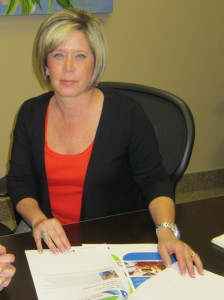 Colleen Mulholland,BCF president, is stick handling the biggest project her organization has been asked to do. They are going to give her a T-shirt. On the following Wednesday, September 3, there will be a Roll Out event at a location in the east end where the full program will be explained along with the procedures people need to follow.
While the Burlington Community Foundation (BCF) has not yet announced a theme, based on the words BCF President Colleen Mulholland uses continually “Above and Beyond” just might be the call.
“This is a huge problem and there are hundreds of people who are hurting – hurting badly” explained Mulholland who is getting by on around four hours of sleep each night.
She is pumped over the size of the challenge and is stretching her team to the limit.
The BCF has encountered a number of desperate situations where they have had to dip into their own coffers to help out.
Their Annual Golf Tournament, being held September 4th, will be asking people to dig deep into those pockets.
A “portal” is being set up on the BCF web site that will have all the forms; all the details and answers to all the questions they think people will be asking.
That team leading this event are covering all the bases. There will be T-shirts for volunteers to wear; there will be coin boxes at every possible retail location. Great opportunity for the Burlington Downtown Business Association to show what they can do – and hopefully both malls are on board as well as all the supermarkets.
This stuff works – but you have to work to make I happen.
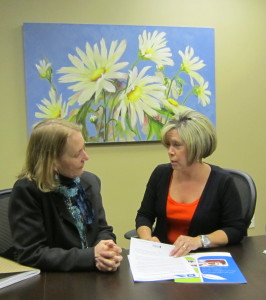 Sandra Baker on the left talks with Burlington Community Foundation president Colleen Mulholland during days when things were not nearly as hectic. On Friday – donations sent via the United Way collection point were at $140,000 but come Monday morning there was just $141,600.00
More is needed – that Above and Beyond call to action is vital.
In the very near future major donations will begin to flow in – but this is a grass roots effort – this is community helping community. We too are Samaritans – or we can be if we choose to do be.


By Pepper Parr
April 19, 2014
BURLINGTON, ON.
We got our first look at what a No Vacancy event was about last year when Selina Jane Eckersall hosted an illustration event at the Waterfront Hotel. It was a little longer than the average movie but it came close to rocking the socks off the Burlington arts community.
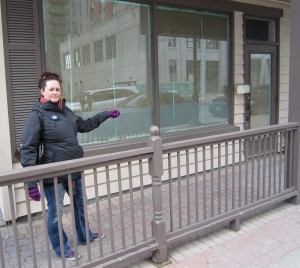 Selina Jane Eckersall points out a location that will be active the No Vacancy Night. Hundreds of people will be crawling through Village Square. It took place at a time when the arts and culture community was beginning to create a presence for itself. The city had accepted the Cultural Action Plan prepared by Jeremy Freiburger and while they weren’t able to act on very much of the plan they did re-allocate a staff member from Parks and Recreation to co-ordinate events that were cultural in nature. This kind of work was being done by the Parks and Recreation department where the culture was more athletic than artistic.
 The No Vacancy event was a critical success and is being repeated this year with a much bigger venue and a more exciting program. Selina Jane Eckersall sums it up with the comment: “We’re looking to give you the best Friday night you’ve ever had.” The No Vacancy event was a critical success and is being repeated this year with a much bigger venue and a more exciting program. Selina Jane Eckersall sums it up with the comment: “We’re looking to give you the best Friday night you’ve ever had.”
There will be 30 unbelievably talented contemporary artists who will transform a variety of spaces inside Village Square into an art experience that will have a lasting impact. “This incredible walking contemporary multi-artist exhibition will feature the best of contemporary installation art from Southern Ontario.”
“Village Square will be buzzing with activity as people explore the alleys and walkways and enter spaces they haven’t explored before. We will also have performance and street art throughout the square and a pop-up art market that will be open until midnight. Burlington has never had an art event quite like this and it is going to be a wondrous experience.”
Half of Pine Street will be closed to traffic and all the space available to No Vacancy in Village Square has been allocated.
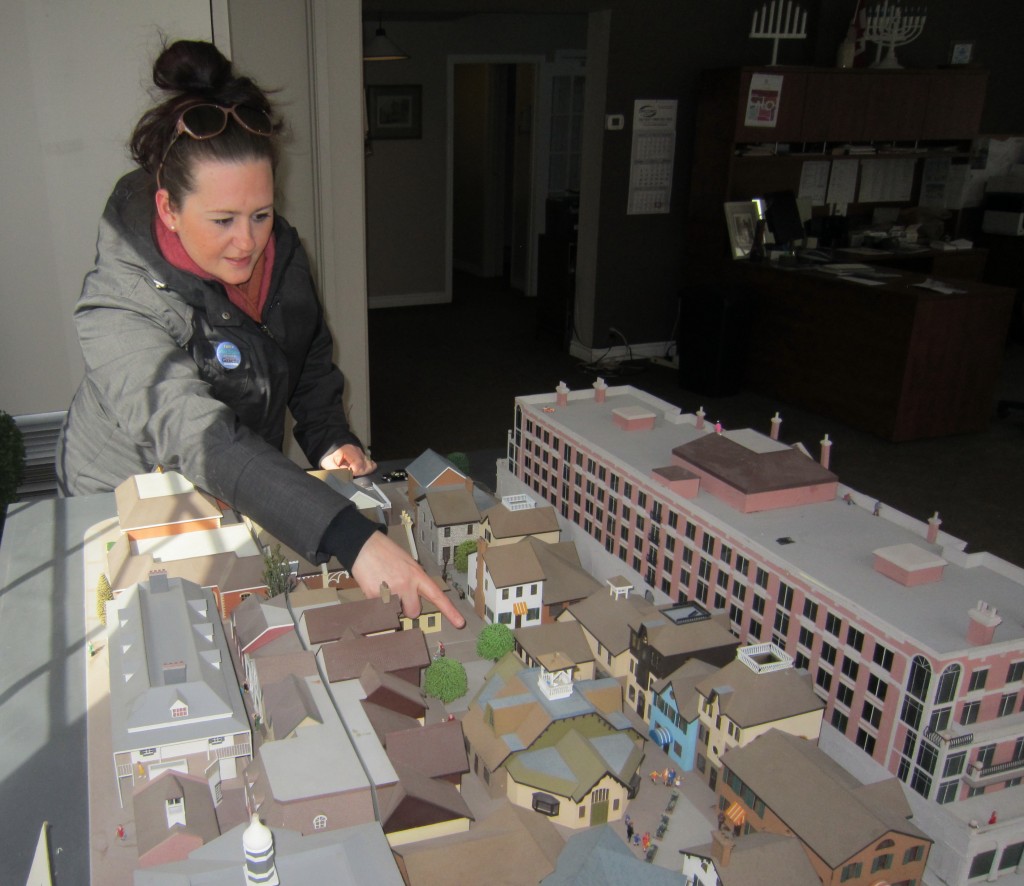 Selina Jane Eckersall points to one of the locations for some of the “installation art” that will be on display for less than four hours September 19 – a not to be missed event. The artists doing the installations are being paid – a bit of a first for Burlington. In the past artists have been asked to donate to various causes – when they themselves are a cause. The beer garden profits will be used to pay the artists that are putting up the installations.
Eckersall is putting on a much bigger event this year and giving the Village Square some life – something it has needed for some time. The longer term plan for No Vacancy is to be quite ambitious. They have organized themselves as an Ontario Not for Profit Corporation and have gotten charitable status in Ontario and are going after federal charitable status.
Later in the year they will apply for Trillium Funding (that’s where a lot of your lottery money goes) so they can develop the much more robust program they have wanted to put in place for some time. “We want to open minds and push people out of their comfort zone just a bit and we feel that we need a bigger presence in the city, which is why we are looking for a place, where we can be seen and the work of the artists we want to highlight can also be seen.”
“We would like to find a building somewhere or work with someone who has space –visibility is key to what we are setting out to do. What we want to create is a facility that is part studio, part media lab and part gallery” said Eckersall. “One of the bigger challenges is to come up with a business model that can result in an operation that is sustainable – we are still working at that”, she added.
“We would really like to find a van we could use to transport some of the material involved. Installation art tends to be quite large.”
Eckersall says she has “no idea how many people are going to show up on September 19th – it could be anywhere between 500 and 5000.” The event will run from 7 pm to 2 am and as Eckersall says : “A night of incredible art installation in Burlington.”
All the space in Village Square have been allocated and the artists are busy working on the fun stuff. Administratively Eckersall is dealing with permits, contracts, and insurance.
There is going to be a “pop up” market. If there are artists out there that are looking for a venue to sell some stuff – touch base.
Eckersall says the event is all about “Art that makes your heart beat faster.”

 By Staff By Staff
August 12, 2014
BURLINGTON, ON
We are a little late getting this to you – the Art Gallery of Burlington issued a Call for photo submissions for the ‘Infinite Daydreams: Reflections on the Sublime Imaginary’ exhibit.
 The AGB says: “The exhibition explores how we respond to the sublime in nature – that sense of wonder, power and beauty we feel looking out at blue skies filled with clouds over the lake’s horizon. This is hard to capture in one photo, so we need lots!” The AGB says: “The exhibition explores how we respond to the sublime in nature – that sense of wonder, power and beauty we feel looking out at blue skies filled with clouds over the lake’s horizon. This is hard to capture in one photo, so we need lots!”
To be a part of a photo installation in the gallery, please send our guest curators:
– one photo of the sky over the lake, or
– one of the horizon
Photos will be added to the exhibition throughout the summer.
Email photos in .jpg format along with your name to infinitedaydreams1@gmail.com
The exhibit runs until August 24th – new material is added regularly.

 By Pepper Parr By Pepper Parr
July 21, 2014
BURLINGTON, ON
He will begin his second year of life on Tuesday. HRH Prince George Alexander Louis of Cambridge, the fourth in line to the Throne and the person, who will at some point become the Monarch of Canada, is also the recipient of a handsomely bound Book of Best Wishes from the people of Burlington.
The idea for the Book of Best Wishes came from the community and was made real by a small committee of four people: Joe Veitch, Susan Fraser, Selina McCall and publisher of the Burlington Gazette Pepper Parr.
Once the fundamentals were in place the group met with the Mayor to get a buy in at that level. While the initiative came from the community, it was important for the city to be onside. The Mayor loved the idea – “cool” he said, and then suggested that the signing period be extended a few days to include Canada Day.
 No fancy “apps” in the classic binding business. Our binder is in the business of restoring ancient volumes and making presentation copies of original work. We are looking forward to their doing our binding for 50 years and then some. Joe Veitch recruited the volunteers needed to be at the tables, where people could sign the sheets and write their greeting.
 This banner, which stood 7 feet high was set out wherever the public was invited to sign the Book of Best Wishes. The challenge now is for the “trust” running this project, to determine what the picture will be for next year. Joan Krygsman and Selina McCaul, designed the banner. First time out on this project, we learned a lot of lessons – almost everything ended up costing more than we had planned.
Many wondered why they couldn’t see the finished product, when they were signing. We had people at a number of places on the same day – and we didn’t know how many signatures we were going to manage to collect – and thus didn’t know how thick the book was going to be.
Special metal plates had to be made for the gold embossing that was to be stamped into the leather. We would set the type, send it to the book binder, who would have the metal plate made. We had to do some guessing as to how many signatures might be collected – that would determine the thickness of the book and also the size of the plate that had to be made.
The book couldn’t be shown to anyone until it was bound and it couldn’t be bound until all the pages with signatures had been collected..
To get around this problem we endured the expense of having a demonstration copy made – a book bound the way the actual version was to be bound, but with blank pages inside.
One doesn’t just send a book to a Prince. Anything of any significance that gets sent to members of the Royal family, goes through the offices of the Governor General at Rideau Hall in Ottawa. Rideau Hall, home of the Governor General has staff that communicates with the various members of the Royal family – well not the Dukes or Princes or the Duchesses personally – but with their staff. All this communication is bound by more protocol than you can imagine.
Because the Book of Best Wishes was a new idea, it took a bit of talking to convince Rideau Hall to go along with us; it wasn’t until they saw a picture of a sample binding that they understood just what we had in mind.
 Citizens signing the Book of Best Wishes at the Burlington Library on New Street. The Mayor convinced us to set up in Spencer Smith Park on Canada Day – that worked out very well.
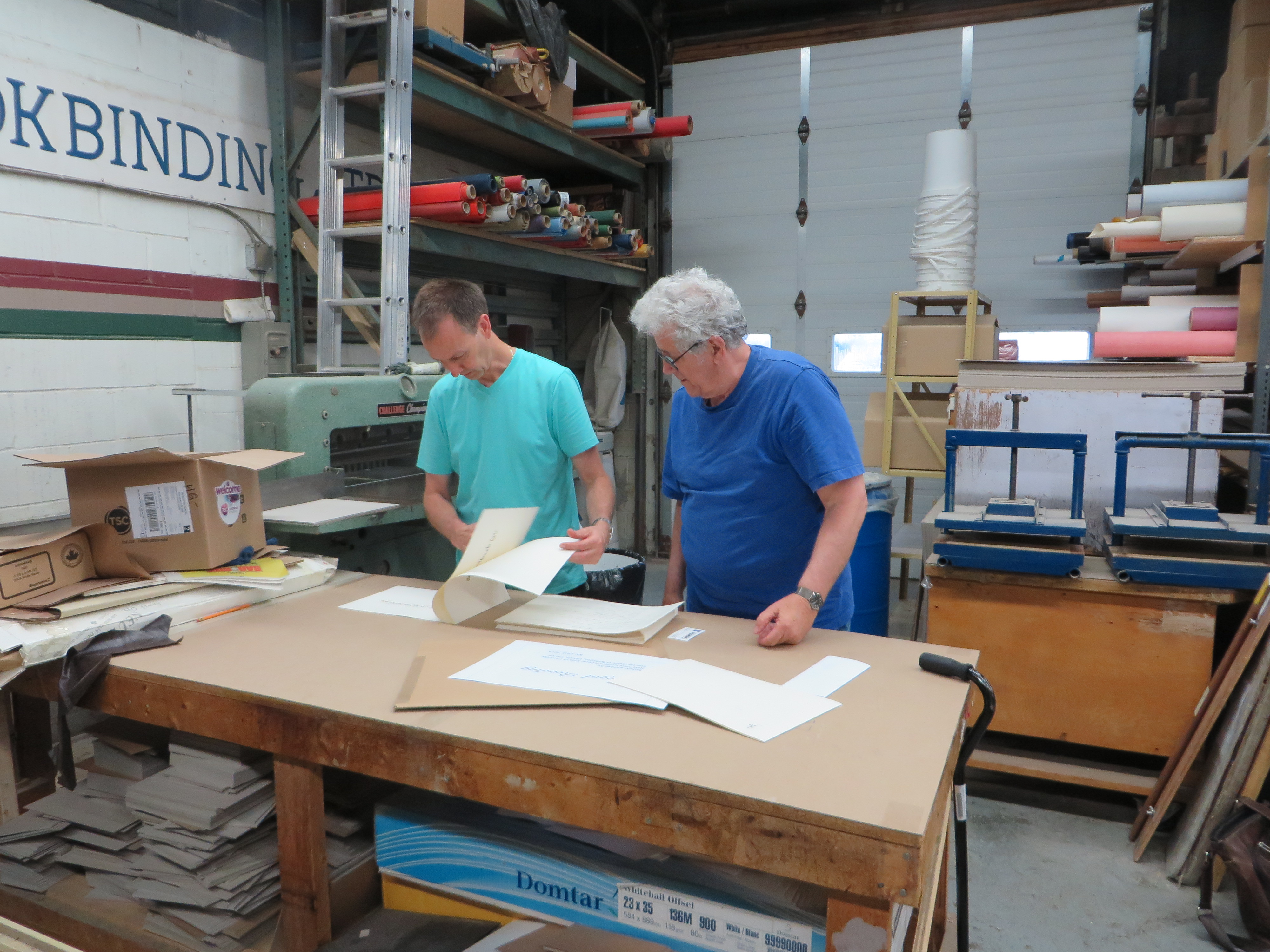 Burlington Gazette publisher Pepper Parr works with binder Keith Felton on the way pages will be gathered together for binding into the first Book of Best Wishes being sent to HRH Prince George Alexander Louis to celebrate his first birthday. The volume was ready in a few days and shipped to Ottawa where it had to be x-rayed before it could be accepted and then sent off to Kensington Palace where the Prince will celebrate his very first birthday.
We have no idea if the Prince will actually see the book – who knows how Royal Families work, but we believe that the parents will see and handle the book – and perhaps wonder just where Burlington is anyway.
The project has been organized as a “trust” so that its members can replicate themselves and ensure that a Book of Best Wishes is sent to the Prince every birthday of his life.
There is more to the project – stay tuned.

 By Staff By Staff
July 16, 2014
BURLINGTON, ON.
Burlington got the McMaster University DeGroote campus but it doesn’t seem to make all that much of a difference to the city – stuck out in a field the way it is.
The campus was supposed to be located in downtown Burlington but like many things planned for the downtown core – that one got away.
Halton regional council voted Wednesday of last week to throw its support behind Wilfrid Laurier University’s efforts to establish a full service campus, adjacent to the Mattamy National Cycling Centre (Milton velodrome).
 Velodrome construction: site has room for a full scale campus if the province goes along with Wilfred Laurier University setting up a satellite campus. seems to be a better deal than Burlington got with McMaster. The campus would provide a range of undergraduate, liberal arts, science and professional programs and a full range of student services for approx. 2,500 students.
Milton has pledged to donate 150 acres of land to Laurier for a new campus including 100 acres of protected land and 50 acres within the proposed 400-acre Milton Education Village (west of Tremaine Road, between Derry Rd. and Britannia Rd.)
Burlington has never managed to exercise the clout it should have at the Regional level. Chair Gary Carr is reported to have said to one candidate for municipal office that Burlington doesn’t seem to fully appreciate the role it can play and gets out-muscled by both Oakville and Milton. The leadership needed by Burlington at the Region just never seems to materialize.
Burlington Council members often go to the Region with different agendas and objectives – frequently not as a team with a consistent objective. We saw that with the Beachway issue.
John Taylor who is experiencing a full-scale snit over the advocacy for safe bike lanes on New Street when the re-surfacing of that road takes place in the near future, argues that the Burlington city council does not pull together all that often. Others argue that because it is a small council – 7 people – it develops a sense of collegiality but at the same time allows each council member to go their own way.
The council members tend to get very territorial as well and fail to recognize that while they are elected to represent a specific ward they are also in place to look after the interests of the city as a whole.
At one city council workshop Councillor Craven spoke in favour of rules that would keep council members out of the turf of another council member. Councillor Meed Ward gave did her best to set him straight on just what the role of a council member is.
Councillor Taylor found himself stepping in for a ward 1 resident in the Beachway who had no water for nine months (don’t ask why – it gets complicated in the Beachway). Councillor Craven was livid.
As much as Mayor Goldring would like to believe that he heads up – doesn’t lead – a collective that is working towards the same goal – it isn’t so.
Milton had no problem agreeing on the donation of a large piece of property in a prime location – 2500 students. Imagine something like that happening to Burlington?

 By Ray Rivers By Ray Rivers
June 29, 2014
BURLINGTON, ON.
Premier Wynne made a number of commitments during the recent Ontario election. Here are three more I think she needs to look at.
1: Improve Democracy
Traditionally the candidate with the highest number of electoral votes wins the election. This works well when there are only two political parties but not so well in our multiparty system. The last provincial election provides an example, where Kathleen Wynne’s Liberals won a majority government with 58 seats but with less than 40% of the vote. This vote splitting among the parties is pretty common place, as Stephen Harper and Jean Chretien also won majorities with less than 40% of the popular vote.
 Is the way we count the ballots working for us? Some jurisdictions have introduced proportional representation, a complicated system engineered to moderate the political advantage of vote splitting. However, voters in referenda recently in B.C., as well as Ontario rejected a move to that system.
Another option involves use of a preferential ballot whereby voters rank their electoral choices in priority. If no candidate gets 51% of the total vote, then the second ballot choices are counted until someone wins, etc. The federal Liberals passed a motion at one of their policy conventions to introduce this system should they form government.
With preferential balloting the winning candidate will always have the support of over half of the voters as their first or second priority choice. There should be fewer minority governments as a result, since the impact of third parties in splitting votes will be diminished. And policies may tend to become more moderate as parties opt to please a broad swath of the public rather than just their own partisan base.
The province also needs to consider implementing electronic voting via the internet to encourage greater voter participation. Less than 60% turnout in a general election is unhealthy for a nation and province that prides itself on government by the people. Australia makes voting compulsory with legal penalties for failing to exercise your franchise.
Electronic voting should also reduce the the high cost of elections and facilitate quicker results. Finally, government may find it useful to include referenda questions on delicate issues as guidance in policy setting, a practice rarely used in Canada. And as for trust-worthy, well, we trust the internet for our banking, don’t we?.
2. Make Public Education Truly Public
There is a condition in the Canadian constitution, originating from the British North America Act of 1867, which enables provinces to retain Catholic schools as part of their educational system. That clause was added at the insistence of Quebec, which ironically has now eliminated its own Catholic schools, as indeed has Newfoundland.
Somehow when the political parties in the last election talked about cost cutting the elephant in the room was our redundant Catholic education system. Duplication at the board level, under-utilized classrooms in older areas, four school buses when there could be two – these are just the most glaring examples of waste.
 Is a separate and a public education system something Ontario can afford? Doesn’t exist in most of the other provinces. Public education is a great equalizer in our society. We may not all be born equal but the class room is a wonderful place for children coming from income, ethnic and religiously diverse households to grow together, better understanding each other and each other’s point of view. Hopefully that provides a formula for a more tolerant, understanding and competitive future for our youth.
3. Raise Taxes to Stem the Red
Ontario has the lowest cost-of-services delivery of any jurisdiction in Canada. Yet we are still running a deficit and our debt is piling up. It’s obvious we need to fix the revenue side of the balance sheet. And that means taxes.
There has been lot of talk about carbon taxes. B.C. and Quebec generate revenue in addition to encouraging energy conservation, though these taxes. In the case of B.C. the tax is revenue-neutral, offset by reductions in other taxes. And revenue neutral is not going to help us with the bottom line, is it?
Road tolls have also been bandied about and the 407, though being the greatest rip-off ever invented by man, is a system that works. Applying that formula to all divided highways and charging a reasonable toll would bring in a lot of revenue, in addition to helping the motorist better understand the value of the time they spend commuting.
 Are inheritance taxes something the government wants to bring back? Great cry from the wealthy if that ever happens. Is it time to bring back inheritance taxes? It’s not like the deceased will complain about paying death taxes. Why is it that we don’t tax lottery and gaming winnings as income?

Ray Rivers writes weekly on both federal and provincial politics, applying his more than 25 years as a federal bureaucrat to his thinking. Rivers was a candidate for provincial office in Burlington where he ran against Cam Jackson in 1995, the year Mike Harris and the Common Sense Revolution swept the province. He developed the current policy process for the Ontario Liberal Party.
Background links:
Catholic Schools More Schools Even More Schools Even More

|
|
 By Ray Rivers
By Ray Rivers


 Ray Rivers writes weekly on both federal and provincial politics, applying his more than 25 years as a federal bureaucrat to his thinking. Rivers was a candidate for provincial office in Burlington where he ran against Cam Jackson in 1995, the year Mike Harris and the Common Sense Revolution swept the province.
Ray Rivers writes weekly on both federal and provincial politics, applying his more than 25 years as a federal bureaucrat to his thinking. Rivers was a candidate for provincial office in Burlington where he ran against Cam Jackson in 1995, the year Mike Harris and the Common Sense Revolution swept the province. 















 sleading.
sleading. The Gazette wrote about this group a few months ago. We told of those 100 Women as well. If it’s something you might be interested in – touch base with them. It’s amazing what women with a cheque book can do – some might put the word “amazing” in big bold black letters.
The Gazette wrote about this group a few months ago. We told of those 100 Women as well. If it’s something you might be interested in – touch base with them. It’s amazing what women with a cheque book can do – some might put the word “amazing” in big bold black letters. 

 All children will receive a free goodie bag and a special surprise from the Rocca Sisters. Stop by their tent and table to say “Hi!” and help celebrate Applefest.
All children will receive a free goodie bag and a special surprise from the Rocca Sisters. Stop by their tent and table to say “Hi!” and help celebrate Applefest.

























 Then there’s the issue that all professional writing is not created equal. I’ll let you in on a secret, within the hallowed halls of writers there exists a snobbery; a class system of sorts. At the risk of having ink spilled on me at the next writers ball, some writers craft content to inform, others to compel. Persuading your prospects and client to engage and interact with you is key.
Then there’s the issue that all professional writing is not created equal. I’ll let you in on a secret, within the hallowed halls of writers there exists a snobbery; a class system of sorts. At the risk of having ink spilled on me at the next writers ball, some writers craft content to inform, others to compel. Persuading your prospects and client to engage and interact with you is key. You also get additional results in the SERPS (Search Engines Results Page) listings – and any time you can secure another top 10 slot, it’s a space your competition cannot.
You also get additional results in the SERPS (Search Engines Results Page) listings – and any time you can secure another top 10 slot, it’s a space your competition cannot.

 There are some good races. Ward 6 is perhaps the best example – with seven people having declared themselves for the seat held by Blair Lancaster – which she won by just a couple of hundred votes
There are some good races. Ward 6 is perhaps the best example – with seven people having declared themselves for the seat held by Blair Lancaster – which she won by just a couple of hundred votes




 The No Vacancy event was a critical success and is being repeated this year with a much bigger venue and a more exciting program. Selina Jane Eckersall sums it up with the comment: “We’re looking to give you the best Friday night you’ve ever had.”
The No Vacancy event was a critical success and is being repeated this year with a much bigger venue and a more exciting program. Selina Jane Eckersall sums it up with the comment: “We’re looking to give you the best Friday night you’ve ever had.”

 The AGB says: “The exhibition explores how we respond to the sublime in nature – that sense of wonder, power and beauty we feel looking out at blue skies filled with clouds over the lake’s horizon. This is hard to capture in one photo, so we need lots!”
The AGB says: “The exhibition explores how we respond to the sublime in nature – that sense of wonder, power and beauty we feel looking out at blue skies filled with clouds over the lake’s horizon. This is hard to capture in one photo, so we need lots!”




 By Ray Rivers
By Ray Rivers



